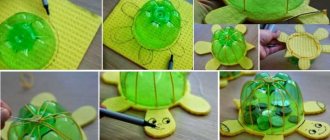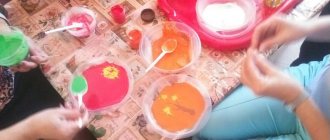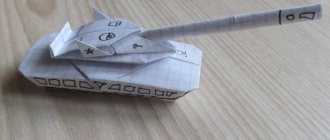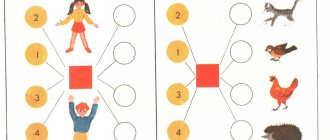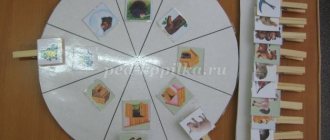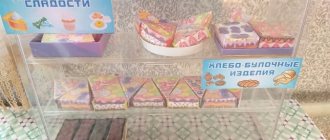Robots Education Creativity
Details Published: 10/22/2018 08:53
How to interest a little fidget in reading? With the help of the LEGO constructor, says Inna Vladimirovna Lazutin , teacher, MADOU “Kindergarten of discoveries and inventions “Eureka” (Perm).
Summary of the master class “LEGO-constructor - letter designer”
Duration of the master class: 12 – 15 minutes.
The purpose of the master class: to teach master class participants the methods and forms of using LEGO constructors during the period when preschoolers are learning to read.
Master class objectives:
- Transfer of experience through direct and commented demonstration of the sequence of actions, methods, techniques and forms of pedagogical activity;
- Joint development of methodological approaches and techniques for solving the problem posed in the master class program;
- Reflection of one’s own professional skills by master class participants;
- Increasing the level of professional competence of master class participants.
Equipment: 2 tables, chairs for 4 participants, notes, LEGO parts, albums on the topic of the master class.
Handouts: reminders
Progress of the master class:
Part I. Organizational moment, selection of master class participants
Hello, always respected by me, kind, strict and adored, dear, close, brave, friendly, needed advisers on every issue, who have read so much in the world, who have known and written a lot, fearless guides of our parents, strong in spirit and not tired, Hello, educators!
I invite you on a fabulous journey, It will be very mysterious, Unusual roads await us, Decent strength will be required. I'll tell you a wonderful fairy tale - Not very short, Not very long, But the same as from me to you!
Maybe this is not a fairy tale, but a reality, I invite here those who have the sound “L” in their name (Lyudmila, Valentina, Olga, Rafilya).
Part II. Introductory part
I suggest you look through the albums that present material on the topic “LEGO-constructor - letter designer”.
Would you like to get the same results from working with your students?
Our goal is to teach you methods and forms of using LEGO constructors during the period when preschoolers are learning to read.
Why do you think we called the LEGO constructor a letter constructor? What are the advantages of playing with this construction set when preschoolers are learning to read?
So, what is a LETTER? A letter is a graphic sign that carries a certain meaning: a designation of sound. When mastering reading, a child learns to associate each sound with a specific sign, remembers it, distinguishes and identifies the characteristic elements of the letter.
In preschool age, a child does not need to learn to write in capital letters; it is enough that he will “type” words. This means that letters can be “printed” using LEGO construction parts.
The undoubted advantage of the Letter Constructor game is the ability to carry out tactile and optical analysis of letters, constructing them from LEGO parts. Moreover, the parts of the designer can simply be superimposed on each other, they can be fastened together, they can be fixed on plates (the master demonstrates the options).
Folding letters from various construction set elements, transforming one letter into another, replacing modules - all this helps the child remember the graphic image of each letter.
In addition, the mental processes of attention, memory and thinking are improved; Fine motor skills and coordination of finger movements develop.
And now, I suggest you test the new technology as part of our master class.
Part III. Main part
So, we will play through several options.
Game "LEGO alphabet"
Game task: build all the letters of the alphabet from various parts of the construction set.
Game options: 1. Build the same letter as mine; 2. Find the same letter in the picture; 3. Build whatever letter you want.
Game "Hide and Seek"
Game task: perform a tactile analysis and name which letter is “hidden”.
Game options: 1. Using an opaque bag or box; 2. Find the given one among several letters laid out on the plate. 3. Look which letter is missing. 4 “The fourth is extra” (3 vowels, 1 consonant).
Game "Transformations"
Game task: replace one or more modules and transform one letter into another.
Game options: 1. Change the letter on the plate; 2. “Grow” the letter up.
Game “One word, two words”
Game task: make a word out of letters.
Game options: 1. Guess what word I want to write (from several letters laid out in advance); 2. Who will write the most words; 3. Make short words from a long word.
Part IV. Final. Reflection
– Please tell me, were you interested? Will your children be interested in this?
Of course, in 10 minutes it is not easy to master all the methods and forms of using the LEGO constructor when preschoolers are learning to read.
In your work you can use small reminders. Thank you for your attention.
Literature:
- Emelyanova I.E., Maksaeva Yu.A. “Development of giftedness in preschool children using the means of lightweight construction and computer gaming complexes.” Linka – Press Moscow 2011
- L.G. Komarova “Building from LEGO”. Linka - Press, Moscow 2001.
- E.V. Feshina “Lego - construction in kindergarten.” Sphere 2012
- M.S. Ishmakova “Design in preschool education under the conditions of the introduction of the Federal State Educational Standard” “Mask” 2013.
Layout of a memo for master class participants
Master class “Robotics in preschool educational institutions”
Author: Anisimova Victoria Alexandrovna
Teacher MBDOU "Kindergarten No. 1" p. Aksha
Master class “Robotics in preschool educational institutions”
Master class for parents
Topic “Robotics in preschool educational institutions”
Target:
to introduce parents to robotics as a modern direction in the development of preschool children in preschool educational institutions.
Tasks:
- demonstration of experience in using Lego robots;
- broadening the horizons of parents;
- creating conditions for the application of new knowledge (practical work on designing and programming a Lego robot).
Preliminary work:
moving folders about robotics; reminders about the role of robotics in the development of preschool children.
Equipment:
interactive whiteboard, computers with the Lego Wedo Programming program, Wedo technological kits - 4 sets, didactic
material
(Microsoft PowerPoint.ptx presentation, folder with the names of parts, instructions.
Stages of work:
- organizational (welcome, introduction to the topic of the master class ) ;
- demonstration (demonstration of the designer of additional sensors)
;
- practical part;
- final part (summarizing, reflection)
.
Progress of the master class
- Organizational stage
- Good afternoon, dear parents! In my practice, I use the new technology of Lego construction with programming elements. Through mastering Lego technologies, students learn the basics of modern robotics with the help of Lego WeDo constructors. Working with these construction sets gives children the opportunity to create bright “Smart” toys, endow them with intelligence, learn the basic principles of PC programming, and learn how to work with motors and sensors. This makes you feel like a real design engineer. Today I want to show you how children work with these construction sets.
- Demonstration part.
Demonstration of the Lego Wedo Programming constructor using a presentation.
— As I already mentioned, the kit includes sensors - tilt and motion sensors, a motor, a LEGO switch with which the assembled model is connected to the computer. The computer has software installed that allows you to assemble and program the model.
Handout
: folders with images and names of designer parts.
- Practical part.
I ask those who wish to go to the tables to gather and “revive”
model, and we will help you.
Our work will consist of 4 stages:
- Assembling the model according to the diagram;
- Connection to a computer;
- Programming;.
— First, you need to conduct a safety briefing. To do this, I will tell you the rules for working with the constructor:
- 1
. For work, a special workplace is organized with free space for assembling models. This could be, for example, a table or desk. It is necessary to provide space for a container with parts and an “assembly site”. That is, in front of each child there should be a free space measuring approximately 60 cm x 40 cm (desk floor). - 2
. Pupils are seated at their workplaces, two at a table (desk). - 3
. One labeled container with a construction set is placed on each table (desk), that is, one set for two people. - After an introductory conversation, only at the direction of the teacher, children begin to design.
- 5
. The constructor must be opened correctly, holding the lid. - 6
. Parts must be kept only in a special container. - 7
. When working in groups, you need to distribute responsibilities: coordinator, assemblers, etc., so that everyone is responsible for their own stage of work. - 8
. When working with a construction set, it is important to pay attention to the details, as they are very small. Handle parts only for their intended purpose. Do not swallow, put construction parts in your mouth or ears, or scatter them on your work table. If a part falls on the floor, you must immediately pick it up and put it in a container or attach it to the structure according to the instructions. - 9
. Accurately follow the teacher’s verbal instructions on robotics. Build the structure according to the attached diagram. - When the teacher speaks to you, pause your work. Don't get distracted while working.
- 11
. Do not use tools and objects whose handling rules have not been studied. - 12
. When working, hold the instrument as indicated in the instructions or as shown by the teacher. - Keep your work area clean and tidy.
- Place the equipment in the order shown.
- 15
. Don't talk while working. - Do your work carefully, do not be distracted by extraneous matters
- 17
. After completing the assembly and playing around with the design, it remains on a marked tray (corresponding to the marking of the container) for some time (evening, day, then disassembled. - The children building it must disassemble the structure.
- The parts are placed in a container corresponding to the markings of the tray on which the structure stood. The container is handed over to the teacher.
- 20
. If you have any questions, please contact your robotics teacher.
— We begin assembling the model according to the diagram, in the left field of the program there are the parts necessary for assembly, and in the right field the sequence of connecting the parts is shown. Let's start assembling.
(model assembly)
Our model is assembled, using a LEGO switch we connect the model to the computer.
- Well done, everyone coped with the task! Sergey, did you manage everything?
- Final part.
Dear parents!
In conclusion, I would like to note that the relevance of LEGO construction and robotics is significant in the light of the implementation of the Federal State Educational Standard, since it is an excellent means for the intellectual development of preschool children and ensures the integration of educational areas, allows the teacher to solve educational, developmental and educational tasks in unity and in the game mode with inclusion experimental and research activities. Children develop cognitive activity, curiosity, constructive abilities, and develop communication and co-creation skills. Master class “Robotics in preschool educational institutions”
MAGAZINE Preschooler.RF
Master class for preschool teachers “Use of Lego technologies in educational activities”Goal: to improve the professional skills of teachers participating in the master class when using Lego technologies in educational activities in the process of active pedagogical communication.
Tasks:
- train master class participants in the skills of using LEGO technology;
- show participants of the master class technologies for working with preschool children in the field of LEGO construction;
- to create motivation among master class participants to use LEGO construction sets in educational activities.
Equipment and materials: LEGO construction set, projector, ball 1 cm in diameter, card index of diagrams and samples for completing tasks, homemade toy Mr. Pochemuchkin, multimedia presentation, light music.
Planned result:
- informing teachers about the system of work on LEGO construction for preschool children;
- formation of teachers’ ideas about the possibility of working with LEGO construction sets.
The master class for teachers includes 3 parts:
- theoretical
- practical
- final
Progress of the master class:
1. Theoretical part.
Good morning, dear colleagues. I am glad to meet you. Today in our master class we will plunge into the world of LEGO.
The most important distinctive feature of the Federal State Educational Standard for Educational Education is the system-activity approach, which involves alternating practical and
mental actions of the child. This approach can be implemented in an educational environment with LEGO, as it allows the child to think, fantasize, and act without fear of making mistakes.
So why Lego? It's simple. From the moment of its inception to the present day, Lego has never changed its motto “Play with
pleasure! For many teachers, Lego is associated only with construction and nothing else.
In my practice, I use the LEGO constructor in various types of activities: in classes, during exercises, in joint, independent and individual work. After all, the inclusion of Lego technology in the educational process of preschool educational institutions occurs through integration into all educational areas. The main thing is that LEGO should be interesting to the teacher himself, then it will be easy and fun to work with children.
And today I would like to present to your attention some aspects of my experience in using Lego technologies in educational activities with children.
2. Practical part.
And in order for our work to be coordinated and successful, I propose to play. Let's stand in a circle, our circle will not be simple, but a circle of joy and good mood. I'm in a great mood and I want to share it with you. Look at this flower. It is not simple, but magical, it is made by children from LEGO construction sets and carries a lot of energy and good mood. Let's give each other a flower and our smile. Well, has your mood improved? Now we can get started!
I invite you to an exciting journey with Mr. Pochemuchkin.
And so that no one gets lost on the way, let's tightly cling our little fingers and say the magic words:
- “I’m taking my friends with me, I’m going to the city of Knowledge
“We can design, Lego will help us with this!”
POCHEMUCHKIN: So you find yourself in the city of Knowledge. It consists of 5 streets. At each of them something interesting awaits you. This is the first street
"Creative".
VED: -Let's see what Mr. Whychkin has prepared for us?
1. Assignment: “Vase with flowers” . (in the card there is a vase template, a diagram of how to build a flower).
VED: -Draw flowers using a Lego brick.
-Make a flower from Lego according to the model.
-Well, Pochemuchkin, did the participants cope with the task?
Pochemuchkin (shows a smiley face, i.e. correctly).
- Well done, you completed the task. Let's move on to Gramotnaya .
2. Task: “Find the sound A”
EDUCATION: -Select and name only those pictures whose names begin with the vowel sound A (bus, mushroom, stork, cube, drum, hedgehog, pyramid,
watermelon, pineapple, clock, aster).
VED: -Using Lego parts, lay out the sound diagram of words, depict vowel sounds with a red brick, and consonants with a blue brick.
POCHEMUCHKIN: emoticon - “Great, forward, just forward!
VED: -Oooh, what an interesting street “Sportivnaya” . Let's find out what awaits us there?
3. Task: Game “Balance”
Participants in the game place a Lego brick on their head, Pochemuchkin gives tasks, for example, to sit down twice, take three steps forward, turn right, stand on the left leg, spin, etc. The task of the participants is not to drop the brick.
VED: - Why?
POCHEMUCHKIN: smiley
- How easily and playfully you complete all the tasks! Let's see how you pass the next test.
VED: -Yeah. This street is "Logical" . Oh, and there will probably be difficult tasks...
4. Task:
- "Mirror" . Task: lay out the second part of the drawing symmetrically.
- “Find a house . Task: choose a place for bricks of different sizes on the card.
VED: Pochemuchkin, the work is ready.
POCHEMUCHKIN: smiley. -And here is the 5th street of “Friendship” , where only a real team can cope with the task. You are ready?
— "YES"
5. Task: “Labyrinth”
Task: lay out the maze so that the ball goes its way from one end to the other.
VED: — While the participants are completing the task, I would like to play with you the game “Whose row will pass the brick faster . (Game with the audience).
- Pochemuchkin, we are ready.
POCHEMUCHKIN: smiley - I see you are a great team! We completed all the tasks. But what I hear (ringing), it's time for you to return. Rather, stand in a circle, place your hands tightly on a Lego brick and say the words:
“One, two, three - Lego bring us all back!”
POCHEMUCHKIN: -Thank you, I really enjoyed traveling with you (CALL), it’s a pity to leave, but it’s time for me to return. Goodbye, see you soon!
3. Final part.
Reflection.
Dear Colleagues. Today I showed you just a few options for using Lego in educational activities. I'm sure you can come up with many interesting games and use them in your work with children.
I'd like to hear from you:
-Was it difficult or easy for you to work?
-Do you have a desire to use this technology?
— What does this work experience give children?
Lego is the most important childhood companion, allowing children to learn through play.
Each Lego building is a fantastic new adventure, each time unusual, always fun, educational and desirable.
And to express your attitude towards the master class I conducted, I ask you to choose Lego bricks:
- red - everything is clear and interesting,
- green - everything is clear, not very interesting,
- blue - nothing is clear and not very interesting.
Thank you for your attention and cooperation! I wish you creative success and good luck!
| Next > |
Construction project in the senior group of kindergarten
Project activity with children of the senior group on the topic “Young Designers”
Author: Olga Vasilievna Petrova, teacher of the highest category in the Samara region. Togliatti ANODO “Childhood Planet “Lada” kindergarten No. 171 “Krepysh”. Project type: Creative, short-term (March). Purpose: This design project may be of interest to preschool teachers, additional education teachers, and parents of preschool children. Goal: To develop independent creative activity through the use of different types of construction sets. Objectives: • Develop the ability to see a structure and analyze its main parts, their functional purposes, determine which parts are most suitable for construction, and how to combine them expediently. • Develop the ability to plan the construction process of a building, transform the finished structure through changes or additions to certain elements. • Strengthen teamwork skills: the ability to negotiate using gestures, distribute responsibilities, work in accordance with a common plan. • Invite parents to participate in joint activities: in the competition for the best joint construction “It’s more fun to build with a construction set together”, in a master class). Relevance: The child is a born inventor and researcher. These inclinations inherent in nature are especially quickly realized and improved in design, because the child has an unlimited opportunity to invent and create his own buildings and designs, while showing curiosity, intelligence, ingenuity and creativity. Required material: Construction set with a variety of mounting methods, for example: “Lego-hollow”, “Burdock”, “Cellular”, “Magnetics”, “Zig-zag”, “Cubus”. Forms of organization of children's design: (L. A. Paramonova)
1. Design according to a model 2. Design according to a model 3. Design according to accessible drawings and visual diagrams 4. Design according to the topic 5. Design according to conditions 6. Frame design 7. Design according to plan .
Expected results: 1. The child creates designs from different types of construction sets at his own request. 2. Uses different means to achieve results (diagrams, models, drawings, samples). 3. Strive to become a participant in a collective role-playing game using crafts from various types of construction sets. Products of the project: • Development of lesson notes “Houses are different”, “Neighborhood”, “Transport”, “Animals”, “Zoo”, “Robots”, “Military equipment”, “Bridges”, “This is what I can do”.
• Selection and design of didactic games and works of art on the topic of the project. • Design of the photo exhibition “Our Favorite Construction Buildings”. • Creation of an album of joint child-parent creativity “It’s more fun to build from construction sets together.” I Preparatory stage:
• Replenishment of the constructive corner with a constructor with different methods of fastening.
• A selection of elementary drawings, photographs, diagrams, drawings, models. • Motivating children for constructive activities through reading fiction, looking at pictures and conversations. Reading fiction: Poems:
K. Lukash “Dad gave me a designer”, T. Shatskikh “About the designer”, V. Mayakovsky “Who should I be?”, “Construction”.
Fairy tales:
“The Three Little Pigs”, N. Nosov “The Adventures of Dunno” Stories: N. Kalinina “Who is good with us”, “How the guys built a house”. Looking at the paintings: “How Mishka built a house”, “We are builders”, “Is this how they play”.
II Main stage:
Didactic games: • “Find the same detail”; • “Remember the location”; • "What changed?"; • “Lay out the other half”; • “Whose team will build the fastest.” Joint activity: Construction of “Houses are different”, “Neighborhood”, “Transport”, “Animals”, “Zoo”, “Robots”, “Military equipment”, “Bridges”, “This is what I can do”.
Participation in the competition “Ecology. The future of the city! III Final stage:
• Exhibition of children's crafts.
• Creation of an album of joint child-parent creativity “It’s more fun to build from construction sets together.” • Design of the photo exhibition “Our Favorite Construction Buildings”. References used: 1. Kutsakova L.V. “Construction from building material. Senior group". 2. Luss T.V. “Formation of skills in constructive play activities in children using Lego.” 3. Feshina E.V. "Lego construction in kindergarten."
We recommend watching:
Project in kindergarten for older preschoolers 5-7 years old on legal topics Project in the senior group of kindergarten Project in the senior group on the topic “Trees and shrubs in spring” Project in the senior and preparatory group of the kindergarten
Similar articles:
Project for children of the senior group “Our cheerful garden”
